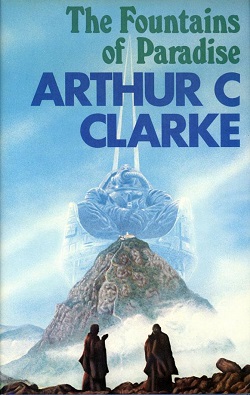| Revision as of 00:54, 10 August 2005 editK1Bond007 (talk | contribs)25,919 edits removed cat per cfd← Previous edit | Revision as of 03:37, 27 August 2005 edit undoEmdx (talk | contribs)Extended confirmed users534 editsNo edit summaryNext edit → | ||
| Line 46: | Line 46: | ||
| In the novel, Clarke envisions a microscopically thin but strong "hyperfilament" that makes the elevator possible. Although the hyperfilament is constructed from "continuous pseudo-one-dimensional ] crystal" in the novel, Clarke later expressed his belief that another type of carbon, ], would play the role of hyperfilament in a real space elevator. | In the novel, Clarke envisions a microscopically thin but strong "hyperfilament" that makes the elevator possible. Although the hyperfilament is constructed from "continuous pseudo-one-dimensional ] crystal" in the novel, Clarke later expressed his belief that another type of carbon, ], would play the role of hyperfilament in a real space elevator. | ||
| The ] in ] technology brings the orbital elevator closer to possible realization. | |||
| ] | ] | ||
Revision as of 03:37, 27 August 2005
| The Fountains of Paradise | ||
|---|---|---|

| ||
| Novel by Arthur C. Clarke | ||
| Released | 1979 | |
| First publisher | Victor Gollancz Ltd, London | |
| First U.S publisher | Harcourt Brace Jovanovich, NY | |
| Genre | Science fiction | |
| Professional reviews | ||
| SF Site | Rich Horton | link |
| SF Reviews.Net | T. M. Wagner | link |
| Awards | ||
| Hugo Award | Best Novel | 1980 |
| Nebula Award | Best Novel | 1979 |
The Fountains of Paradise is a 1979 novel by Arthur C. Clarke. Set in the 22nd century, it describes the construction of a space elevator. This orbital "beanstalk" is a giant structure rising from the ground and linking with a satellite in geostationary or Clarke Orbit at the height of approximately 36,000 kilometers. Such a structure would be used to efficiently and effectively raise payloads to orbit without having to use rockets.
In the novel, Clarke uses the life of the ancient king Kalidasa to foreshadow the adventures of engineer Vannevar Morgan in his single-minded determination to realize the space elevator. Subplots in the novel include human colonization of the solar system and the first contact with extraterrestrial intelligence. Clarke also hypothesizes that religion in humans is a consequence of sexual reproduction, although the idea does not play a central role in the novel. The Fountains of Paradise is set in the fictional country of Taprobane, which Clarke has described as "about ninety percent congruent with the island of Ceylon (now Sri Lanka)".
In the novel, Clarke envisions a microscopically thin but strong "hyperfilament" that makes the elevator possible. Although the hyperfilament is constructed from "continuous pseudo-one-dimensional diamond crystal" in the novel, Clarke later expressed his belief that another type of carbon, Buckminsterfullerene, would play the role of hyperfilament in a real space elevator.
The latest developments in carbon nanotube technology brings the orbital elevator closer to possible realization.
Categories: